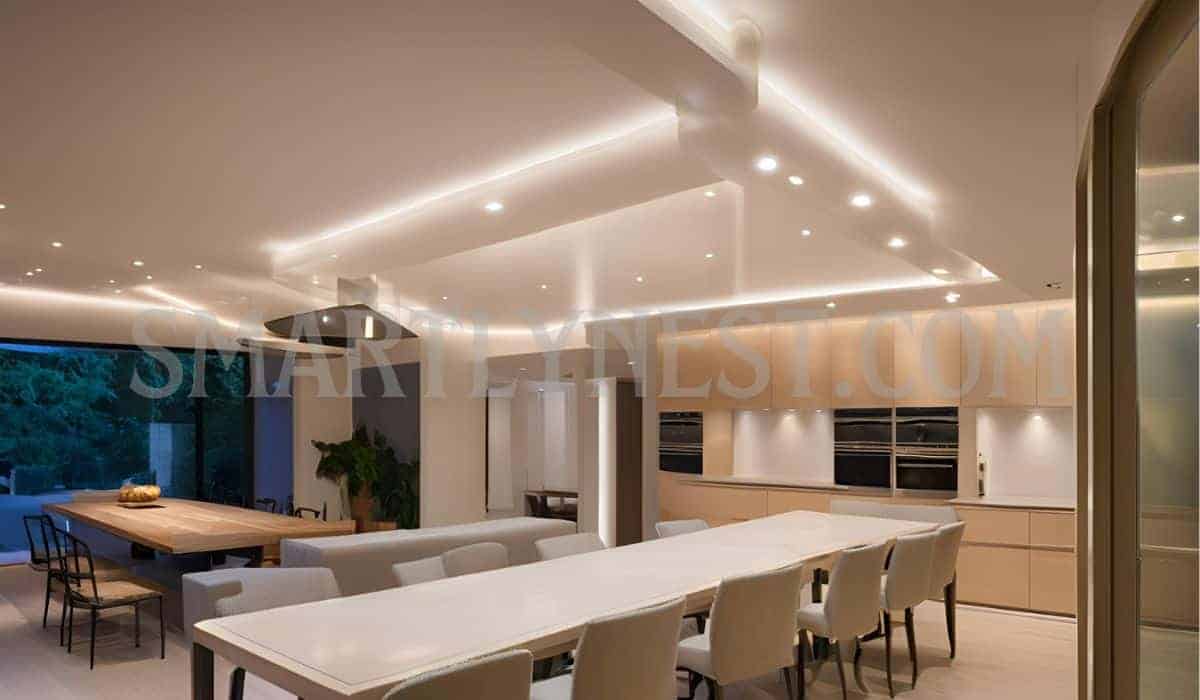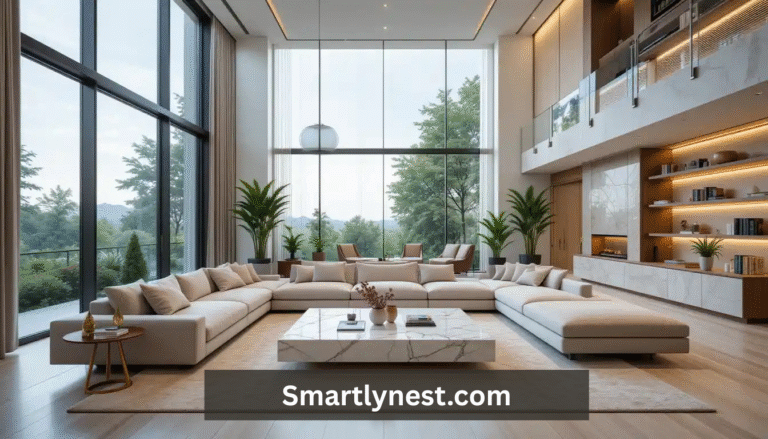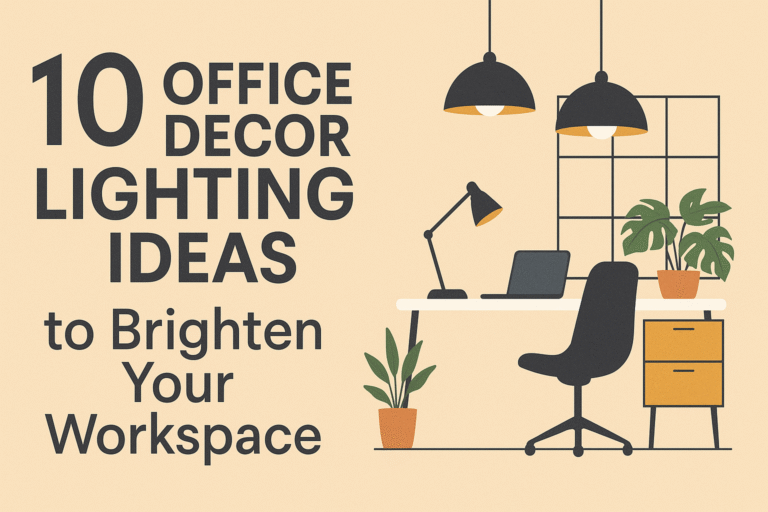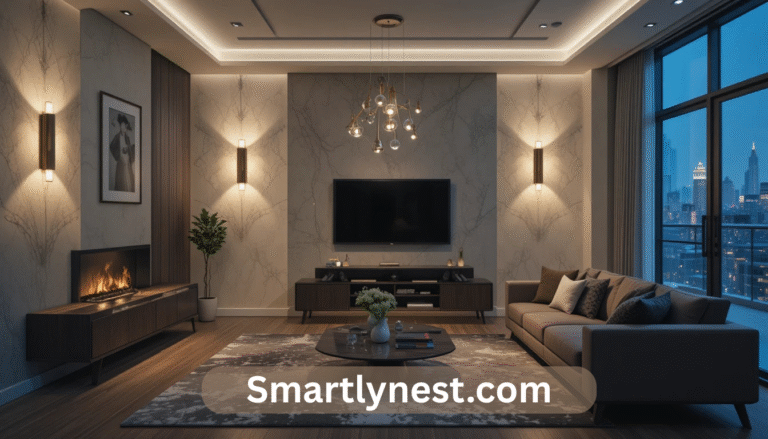
Lighting plays a crucial role in shaping the atmosphere of your home. It’s not just about illuminating spaces; it’s about creating the right ambiance, highlighting key features, and enhancing the overall aesthetic. Whether you’re redesigning your home or just adding a few tweaks to your existing décor, the right lighting can make all the difference. In this post, we explore 21 interior lighting ideas that will brighten and elevate every room in your house.
21 creative Interior Lighting Design Ideas
1. Layered Lighting Approach
What Is Layered Lighting?
Layered lighting is the secret to achieving balance and depth in a room. By combining different types of lighting—ambient, task, and accent—you can create a space that’s not only functional but visually dynamic. Each layer of light serves a different purpose, and when combined, they make a room feel complete.
- Ambient Lighting: This is your primary source of light, meant to fill the room with general illumination. Think ceiling lights, recessed lights, or chandeliers that provide an even glow across the space.
- Task Lighting: This focuses on specific areas for activities like reading, cooking, or studying. It’s essential in areas like kitchens or home offices. Examples include under-cabinet lights, desk lamps, and pendant lights.
- Accent Lighting: Accent lighting highlights specific features, creating visual interest. It’s great for highlighting artwork, architectural details, or plants. Wall-mounted sconces, track lighting, and even string lights can work here.
How to Implement Layered Lighting in Different Rooms
- Living Room: A combination of a central ceiling light (ambient), floor lamps or table lamps for reading (task), and spotlights to highlight artwork or décor (accent) creates a well-rounded space. If your living room has architectural details like a fireplace, use accent lighting to draw attention to those elements.
- Kitchen: In the kitchen, ambient lighting can come from overhead fixtures or recessed lights. Under-cabinet lights provide the task lighting you need for food prep, while accent lighting can come from pendant lights over your island or decorative track lights. Layering these three types will ensure your kitchen is both functional and stylish.
2. Statement Chandeliers
The Power of a Chandelier
Chandeliers aren’t just lighting fixtures—they’re works of art that can define the style of a room. A statement chandelier can serve as the centerpiece of a room, making a bold visual statement while providing ample illumination.
Choosing the Right Chandelier
When selecting a chandelier, you need to consider several factors:
- Size and Scale: A chandelier should be proportional to the room’s size. In a dining room, for instance, the diameter of the chandelier should be about 12 inches narrower than the table on which it hangs. For larger rooms, consider larger chandeliers that won’t be dwarfed by the space.
- Style: There are chandeliers for every style—from ornate crystal designs for a more traditional home, to sleek, modern designs for contemporary spaces. Choose a style that complements the rest of the room’s décor.
- Height: The height at which you hang your chandelier matters. For dining rooms, a chandelier should hang about 30 to 34 inches above the table. In larger rooms like living rooms or foyers, you can hang the chandelier higher to allow for easier movement.
The Impact of a Statement Chandelier
A well-chosen chandelier can immediately elevate a space. It adds drama and elegance, creating a focal point that draws the eye upward. Imagine walking into a grand foyer with a crystal chandelier casting a warm, inviting glow, or dining beneath a stunning brass fixture that adds both character and functionality to the room.
3. Recessed Lighting
What Makes Recessed Lighting So Popular?
Recessed lighting, often called can lighting, is a sleek and minimalist lighting solution. These lights are embedded into the ceiling, making them virtually invisible when not in use. Because of their design, recessed lights are ideal for creating a modern and clean aesthetic in any room.
Where to Use Recessed Lighting
Recessed lighting is versatile and can be used in several different areas:
- Kitchens: These lights provide consistent, even illumination, ideal for task-oriented spaces like countertops and sinks. It’s perfect for a clean, professional feel.
- Hallways and Corridors: In areas where a flush design is important—like hallways or small entryways—recessed lighting provides practical, unobtrusive illumination. Spacing the lights 4-6 feet apart ensures a well-lit path.
- Bathrooms: Recessed lighting above mirrors helps eliminate shadows, ensuring that the space is well-lit for grooming tasks. Adding dimmable features can also help you control the ambiance, especially for relaxing baths.
Key Considerations for Recessed Lighting
When installing recessed lighting, there are a few things to keep in mind:
- Spacing: To avoid creating dark spots, lights should be placed around 4-6 feet apart.
- Dimming: Adding dimming features to recessed lights allows you to adjust the brightness depending on the time of day and the mood you want to create.
4. Pendant Lights
Versatility of Pendant Lighting
Pendant lights are incredibly versatile and can be used in nearly any room. They are often used as a stylish alternative to chandeliers and offer more flexibility in terms of design and placement.
Where to Use Pendant Lights
- Kitchens: Pendant lights over an island or breakfast bar add a touch of style while providing focused lighting for cooking or eating.
- Dining Rooms: Over a dining table, pendant lights can create a cozy, intimate atmosphere. Grouping several pendants together at different heights can add a dynamic touch to the room.
- Living Rooms: A single large pendant can serve as the central light source for smaller living rooms or as an accent piece in larger rooms.
Creative Pendant Lighting Ideas
- Clustered Pendants: Hang multiple small pendants at varying heights to create a visually dynamic focal point. This works especially well over dining tables or kitchen islands.
- Long, Linear Pendants: For larger spaces, opt for long, linear pendants to provide ample light and create a modern, streamlined look. These work beautifully in kitchens, especially above islands or counters.
Installation Tips for Pendant Lights
- Height: When installing pendant lights, the general guideline is to hang them 30 to 36 inches above a dining table or countertop. If you’re installing multiple pendants, be sure to vary the heights slightly for added visual interest.
- Spacing: For clustered pendants, try placing them 6-8 inches apart for balance, ensuring the arrangement doesn’t overwhelm the room.
5. Wall Sconces
The Beauty of Wall Sconces
Wall sconces are an elegant and space-saving lighting solution. They not only provide illumination but also help in framing the space aesthetically. Wall sconces are ideal for creating a softer, ambient lighting effect and are perfect for smaller rooms where floor space is limited.
Where to Use Wall Sconces
- Bedrooms: Wall sconces can replace table lamps, offering a sleek, modern look. Install them on either side of the bed to create balanced lighting for reading or relaxing.
- Hallways: Wall sconces in hallways can add warmth to otherwise narrow, utilitarian spaces. They help soften the light and make the space feel more inviting.
- Living Rooms: Use sconces to highlight artwork, add ambiance, or provide task lighting next to reading chairs.
Design Considerations for Wall Sconces
- Adjustability: Many wall sconces come with adjustable arms or rotating heads, allowing you to direct light exactly where it’s needed.
- Finish: Wall sconces are available in various finishes—from sleek chrome to rustic brass. Consider the overall décor of the room when choosing a finish.
6. Under-Cabinet Lighting
Practicality Meets Style
Under-cabinet lighting is a fantastic way to add both functionality and aesthetic appeal to your kitchen. These lights provide focused illumination to countertops, making meal prep easier, while also creating an inviting atmosphere.
Types of Under-Cabinet Lighting
- LED Strips: These are the most popular choice due to their energy efficiency and easy installation. LED strips can be installed under cabinets and provide even, bright light across your countertops.
- Puck Lights: Smaller, round lights that can be placed strategically under cabinets to highlight specific areas or create a spotlight effect.
Benefits of Under-Cabinet Lighting
- Enhanced Functionality: Provides direct lighting for tasks like cooking, reading recipes, or chopping vegetables. It eliminates shadows and dark spots that can hinder your work.
- Aesthetic Appeal: When installed correctly, under-cabinet lights add a modern and sleek look to your kitchen. They can also create a glowing effect in the evening, making your space feel more inviting.
7. Floor Lamps
Adding Warmth with Floor Lamps
Floor lamps offer both style and versatility, and they’re easy to move around. They can be used to provide targeted lighting, ambient light, or even as décor pieces in a room.
Ideal Locations for Floor Lamps
- Living Rooms: A stylish floor lamp next to a sofa or armchair creates a cozy reading nook. Choose a lamp with a wide base for added stability.
- Bedrooms: A floor lamp beside the bed can replace table lamps and free up valuable bedside table space.
- Offices: For desk work, a floor lamp provides direct light without taking up valuable desk space. Adjustable arm lamps can direct light exactly where you need it.
8. Table Lamps
Functionality Meets Style
Table lamps are not only practical for task lighting but also serve as a key design element in a room. The right lamp can enhance the décor and mood of your living space. Whether you want a soft, cozy glow or a focused beam of light for reading, table lamps have the versatility to achieve both.
Where to Place Table Lamps
- Living Room: A well-placed table lamp on a side table can provide cozy lighting for evening relaxation. For a symmetrical look, place matching lamps on either side of the sofa.
- Bedroom: Table lamps are perfect for bedside tables. Choose adjustable models to control the light intensity and direction for reading or ambient light.
- Entryway: A stylish table lamp in the foyer creates a welcoming atmosphere when you walk through the door. Opt for a larger lamp with an elegant shade to make a statement.
Choosing the Right Table Lamp
When selecting a table lamp, consider the room’s style and the lamp’s functionality:
- Modern: Choose sleek, minimalistic lamps with geometric shapes and neutral tones.
- Traditional: Go for classic designs with intricate bases and fabric shades.
- Industrial: Look for lamps with exposed bulbs, metal finishes, and vintage elements.
Styling Tip: To enhance the aesthetic, choose lamps that complement your other furnishings. For instance, match the lamp’s color to throw pillows or artwork for a cohesive look.
9. Track Lighting
A Flexible Lighting Solution
Track lighting offers the flexibility to direct light wherever it’s needed. With adjustable heads mounted on a track, this lighting style is ideal for spaces where you want to highlight specific features, such as artwork, architectural details, or even entire rooms.
Where to Use Track Lighting
- Living Room: Install track lighting along the ceiling to create a dynamic, directional lighting scheme. This is perfect for showcasing a gallery wall or highlighting a feature such as a fireplace.
- Kitchens: Track lighting can be used over counters and islands for task lighting, ensuring that every surface is well-lit while cooking.
- Hallways: For long corridors, track lighting offers the ability to illuminate specific sections or areas, making your hallway feel less cavernous.
How to Style Track Lighting
- Multiple Heads: Opt for tracks with several adjustable heads for maximum flexibility. These can be directed to illuminate different sections of the room.
- Monorail Design: A curved monorail design can create a sense of fluidity in the room, making it a great fit for modern, open-concept spaces.
10. Cove Lighting
Subtle, Soft Ambiance
Cove lighting is a great way to add a soft, indirect glow to any room. Installed in a recessed space, such as along the edge of the ceiling, it provides a gentle illumination that helps enhance the room’s mood without being overpowering.
Where to Use Cove Lighting
- Living Room: For an atmospheric, relaxing vibe, place cove lighting around the perimeter of the ceiling. This can create an elegant glow that complements other lighting sources.
- Dining Room: Cove lighting around the top of the walls can provide ambient light without casting harsh shadows, creating a serene dining experience.
- Bedrooms: Place cove lights above crown molding or behind a headboard to create a serene, calming atmosphere for sleep and relaxation.
The Magic of Indirect Lighting
Cove lighting works by bouncing light off the ceiling or walls, which helps diffuse the light evenly across the room. This indirect lighting method ensures that the light doesn’t overpower the space, making it perfect for creating a tranquil environment.
11. Smart Lighting Systems
Lighting for the Modern Home
Smart lighting systems are changing the way we think about lighting. With the ability to control lights remotely via apps or voice commands, smart lighting gives you greater control over your home’s ambiance, making it a fantastic option for tech-savvy homeowners.
Features of Smart Lighting
- Voice Control: Integration with voice assistants like Amazon Alexa, Google Home, or Apple HomeKit allows you to control the lights with just your voice.
- Color-Changing Lights: Create any atmosphere you desire by adjusting the color temperature or even the color of your lights. Perfect for mood settings or accent lighting.
- Scheduling: Set your lights to automatically turn on or off at specific times, such as having your living room lights dim as the evening progresses or brightening your kitchen lights in the morning.
Benefits of Smart Lighting
- Energy Efficiency: Smart bulbs are often LED-based, consuming less power and lasting longer than traditional bulbs.
- Convenience: With remote control capabilities, you can turn your lights on or off from anywhere, whether you’re home or away. This feature is especially useful for security purposes.
12. Dimmable Lighting
Adjustable Lighting for Every Mood
Dimmable lighting offers versatility by allowing you to control the intensity of the light. Whether you want bright light for tasks or a softer ambiance for relaxation, dimmable fixtures make it easy to set the right mood.
Best Applications for Dimmable Lighting
- Living Rooms and Bedrooms: Dimmable lights are ideal for spaces where you may want to adjust the brightness based on the time of day or activity. In the evening, dim the lights for a cozy movie night or bright lighting for reading.
- Dining Rooms: Dimming the lights during a dinner party can create a warm, inviting atmosphere that encourages conversation.
- Kitchens: When cooking, you may need bright, focused lighting. But dimming it down while enjoying a meal can create a calm and relaxing environment.
Installing Dimmable Lights
For a modern touch, install dimmer switches for both overhead lighting and accent fixtures, giving you full control over your space’s brightness. Remember, not all bulbs are compatible with dimming features, so make sure you’re using dimmable bulbs for the best results.
13. Maximizing Natural Light
The Beauty of Natural Light
Maximizing natural light in your home not only saves on energy but also contributes to a brighter, more welcoming space. Sunlight can enhance your mood, increase productivity, and help plants thrive.
How to Maximize Natural Light
- Windows and Glass Doors: Keep windows clear of heavy drapes and invest in light, sheer curtains to allow more sunlight to filter in. Consider installing larger windows or glass doors to invite more natural light into your living spaces.
- Mirrors: Strategically placed mirrors can reflect sunlight around the room, making a space feel brighter and more expansive.
- Skylights: In rooms where windows are scarce, skylights are an excellent option for bringing natural light indoors, especially in bathrooms and kitchens.
Benefits of Natural Light
- Health and Well-being: Exposure to natural light is known to improve mood and boost energy levels.
- Sustainability: Reducing reliance on artificial lighting can help lower energy bills and reduce your home’s carbon footprint.
14. Accent Lighting for Artwork
Highlighting Art with the Right Lighting
Artwork can transform a room, but it’s important to showcase it properly with accent lighting. The right light not only illuminates the art but also enhances its color, texture, and details, making it the focal point of the room.
Best Types of Accent Lighting for Art
- Picture Lights: These are mounted above or below artwork to cast a focused light directly onto the piece. Picture lights come in various sizes, and they’re ideal for framing a painting or photograph.
- Track Lighting: Adjustable track lights allow you to direct light at different angles, perfect for displaying multiple pieces of art in a gallery-style layout.
- Wall Washers: Wall washers spread light evenly over a large surface, ensuring your artwork is evenly lit.
Placement Tips for Accent Lighting
When lighting artwork, make sure the light is directed at the piece at a 30-degree angle. This prevents glare while highlighting the artwork without washing it out. The intensity of the light should also be adjustable to match the mood of the room.
15. Outdoor and Landscape Lighting
Bringing Your Outdoors to Life
Outdoor lighting is essential for creating a welcoming and functional outdoor living space. Whether you’re hosting a gathering or simply enjoying your backyard, the right lighting can make your outdoor areas come alive at night.
Outdoor Lighting Ideas
- Pathway Lights: Use low-voltage lights along walkways, driveways, and garden paths to provide both illumination and visual appeal.
- String Lights: For a casual and romantic feel, string lights can be draped across fences, trees, or pergolas, creating a magical ambiance.
- Spotlights: Use spotlights to highlight key landscape features, such as trees, fountains, or sculptures. They can also be placed along the exterior of your home to draw attention to architectural features.
Choosing Outdoor Lighting
- Weather Resistance: Ensure that your outdoor lighting fixtures are weather-resistant and designed to withstand the elements.
- Energy Efficiency: Solar-powered lights are a great eco-friendly option for outdoor spaces. They are easy to install and require no wiring, making them perfect for gardens and pathways.
16. Energy-Efficient Lighting Solutions
Eco-Friendly and Cost-Effective Lighting
Switching to energy-efficient lighting not only helps reduce your environmental footprint but also saves you money in the long run. With a variety of eco-friendly options available, making the switch is easier than ever.
Types of Energy-Efficient Lighting
- LED Bulbs: LED bulbs use less energy and last significantly longer than traditional incandescent bulbs. They are available in a variety of shapes and sizes, making them suitable for almost any fixture.
- CFL Bulbs: Compact fluorescent lights (CFLs) are another energy-efficient option, consuming less power than incandescent bulbs while still providing ample light.
- Smart Lighting: As mentioned earlier, smart lighting systems often come with energy-saving features, such as automatic dimming and scheduling, allowing you to optimize energy use throughout the day.
Benefits of Energy-Efficient Lighting
- Lower Utility Bills: Energy-efficient lights use less electricity, reducing your monthly energy consumption and lowering your utility bills.
- Longer Lifespan: LED and CFL bulbs last significantly longer than incandescent bulbs, which means fewer replacements over time and less waste.
17. Color Temperature Selection
Setting the Mood with the Right Lighting Temperature
Color temperature is one of the most overlooked but crucial aspects of lighting design. It refers to the hue of the light emitted by a light bulb, which is measured in Kelvin (K). From warm, yellowish tones to cool, bluish hues, the color temperature can significantly affect the ambiance of a room. It has the power to influence mood, functionality, and even energy levels, making it an essential tool for creating the perfect lighting scheme in your home.
Understanding how to select and adjust the right color temperature for your space can enhance your comfort and productivity. Whether you’re setting a cozy vibe for a living room or brightening a workspace, the correct lighting temperature will support the room’s intended use and the feelings you want to evoke.
Understanding Kelvin and Its Impact on Room Atmosphere
Color temperature is measured in Kelvin (K), and the range generally spans from 2700K to 6500K. The lower the Kelvin number, the warmer and more yellow the light appears. Higher Kelvin values give off cooler, bluish light, mimicking daylight. Here’s a breakdown of how different temperatures affect a room:
- 2700K-3000K (Warm White): These colors create a cozy, intimate, and relaxing environment, commonly found in living rooms, dining rooms, and bedrooms. This light mimics the warm glow of traditional incandescent bulbs.
- 4000K-5000K (Cool White): Neutral light that appears bright without being harsh, ideal for workspaces, kitchens, and bathrooms. Cool white light enhances clarity and focus, making it a great option for task-oriented spaces.
- 5000K-6500K (Daylight): Mimics natural daylight, offering bright and clear illumination. It’s great for spaces where high visibility is necessary, such as home offices, reading rooms, or craft areas.
Choosing the Ideal Color Temperature for Different Rooms
Lighting needs vary across different areas of your home. Each space requires a different ambiance and purpose, so it’s important to select the color temperature that best suits its function. Below are recommendations for each room based on their usage:
Living Room (Warm White, 2700K-3000K)
- Mood: The living room is meant to be a space for relaxation and socializing. Soft, warm white lighting helps to create a cozy, inviting atmosphere.
- Lighting Tips: Use a combination of floor lamps, table lamps, and pendant lights. The warmth of the light will create a comfortable environment, ideal for unwinding after a long day or hosting friends and family.
Kitchens (Cool White, 4000K-5000K)
- Functionality: Kitchens require bright, focused light for meal preparation and cooking. Cool white lighting ensures that you can see every detail and maintain precision while working in this area.
- Lighting Tips: Use under-cabinet lighting, recessed lights, and track lights to provide even illumination across the entire kitchen. The cooler tones will promote alertness and energy, making it easier to stay focused during meal prep.
Bathrooms (Cool White, 4000K-5000K)
- Functionality: Bathrooms are task-oriented spaces, used for grooming, shaving, and applying makeup. Cool white lighting provides clear, bright illumination needed for these activities.
- Lighting Tips: Vanity lights on either side of the mirror are crucial to avoid shadows on your face. Ensure that your bathroom light is neither too yellow (which could distort colors) nor too blue (which could make the space feel cold).
Bedrooms (Warm White, 2700K-3000K)
- Mood: The bedroom should be a peaceful and tranquil place. Warm white light creates a restful atmosphere conducive to relaxation and sleep.
- Lighting Tips: Use table lamps, wall sconces, or soft overhead lighting with dimmable features to set the mood for sleep. Avoid harsh, cool lights, which can interfere with your circadian rhythm.
Home Offices (Daylight, 5000K-6500K)
- Functionality: A home office requires bright, stimulating light that promotes focus and concentration. Daylight color temperatures mimic the natural light outside, making it easier to stay alert and productive.
- Lighting Tips: A combination of overhead lighting and task-specific desk lamps with daylight bulbs will help illuminate your workspace without straining your eyes. Daylight lighting helps with mood regulation and boosts productivity.
Dining Rooms (Warm White, 2700K-3000K)
- Mood: Dining rooms are places where people gather to eat, making a warm and welcoming atmosphere essential. Warm white lighting complements the tone of a meal and creates an intimate setting.
- Lighting Tips: Pendant lights above the dining table or chandeliers with dimming capabilities can provide adjustable brightness depending on the time of day and the atmosphere you wish to create.
18. Mirror Lighting
Brightening Spaces with Reflections
Mirrors do more than just help you check your appearance—they also play a crucial role in lighting. Strategically lighting mirrors can amplify natural light and make a space feel larger, brighter, and more open. Whether in a small room or a large bathroom, proper mirror lighting can transform the feel of the room.
How to Light a Mirror
- Overhead Lighting: Install overhead lights above a mirror to provide even illumination, avoiding shadows that can distort your reflection. For bathrooms, consider vanity lights above or on either side of the mirror.
- Backlit Mirrors: A modern and elegant option, backlit mirrors are illuminated from behind with LED strips, providing soft, indirect light that adds a dramatic effect to your space.
- Wall-Mounted Lights: For a more classic look, wall-mounted fixtures can be installed around mirrors. These are especially useful in bathrooms, where you need good lighting for grooming.
Benefits of Mirror Lighting
- Increased Light Reflection: A well-lit mirror reflects more light into the room, making smaller spaces feel larger and brighter.
- Aesthetic Appeal: Mirror lighting can add a sophisticated touch to the room, especially when using backlit or framed lighting designs.
19. Ceiling Fans with Integrated Lighting
Practical and Stylish Air Circulation
A ceiling fan with integrated lighting combines two essential functions: air circulation and illumination. Ideal for both functionality and aesthetics, ceiling fans with lights can enhance the comfort and atmosphere of any room.
Where to Use Ceiling Fans with Lights
- Living Rooms and Bedrooms: Perfect for keeping the air cool in warmer months, ceiling fans with integrated lighting offer both comfort and style, especially in larger rooms that need consistent air circulation.
- Patios and Sunrooms: In spaces where the climate may fluctuate, ceiling fans with lights help create a comfortable environment without sacrificing lighting quality.
Choosing the Right Ceiling Fan
- Size and Design: Select a fan that suits the room’s size and style. A fan with a larger diameter is better suited for large rooms, while smaller fans work best in compact spaces.
- Energy-Efficient Options: Opt for energy-efficient ceiling fans with LED lights to minimize energy usage while providing both airflow and illumination.
20. LED Strip Lights
Versatile and Customizable Lighting
LED strip lights are one of the most flexible lighting options available today. These strips of LEDs can be cut to size and placed almost anywhere, allowing you to customize the lighting in any room.
Creative Applications for LED Strips
- Under-Cabinet Lighting: Install LED strips under kitchen cabinets to brighten workspaces and add a modern touch to the kitchen.
- Backlighting for TVs or Monitors: Adding LED strip lighting behind your television or computer monitor reduces eye strain and enhances the viewing experience by creating ambient light.
- Accent Lighting: Use LED strips to highlight architectural features, such as columns, moldings, or shelving units. Their flexibility allows for seamless integration into almost any design.
How to Install LED Strip Lights
- Choose the Right Color: LED strips come in a range of colors, from warm white to vibrant RGB hues. Depending on the mood you want to create, select the color temperature or change colors based on your preference.
- Flexible Placement: Install LED strips under furniture, along the edges of walls, or on the back of picture frames to create a soft, glowing effect.
21. Ambient Lighting with Light Diffusers
Softening the Light for a Cozy Atmosphere
Light diffusers are a simple yet effective way to soften the intensity of light and create a warm, welcoming atmosphere. By scattering the light across a larger area, diffusers help eliminate harsh shadows and evenly distribute the light throughout a space.
Where to Use Light Diffusers
- Living Rooms: Ambient lighting with diffusers can create a warm, relaxing vibe that is ideal for winding down in the evening.
- Dining Rooms: When placed over chandeliers or pendant lights, diffusers can soften the light and create a more intimate dining experience.
- Bedrooms: Place diffusers on bedside lamps or over light fixtures to generate a cozy, tranquil mood for sleep and relaxation.
Types of Diffusers
- Lampshades: The most common form of diffuser, lampshades made of fabric or frosted glass help soften the direct light emitted from bulbs.
- Ceiling Diffusers: These can be installed in recessed lights or overhead fixtures, scattering light across the room without creating harsh spots.
- Floor and Table Lamp Diffusers: Portable diffusers placed in lamps can create a cozy, ambient glow while also adding decorative flair to your space.
How to Mix and Layer Different Color Temperatures
While it’s essential to choose the right color temperature for each room, sometimes blending different lighting temperatures within a single space can create a balanced, dynamic atmosphere. This approach, known as layered lighting, uses multiple sources of light at different color temperatures to add depth and versatility.
- Ambient Lighting: Use warm white lighting for general, ambient lighting across the room. This provides an overall soft glow that doesn’t overpower the space.
- Task Lighting: Add cool white lighting for areas where specific tasks are performed, such as reading, cooking, or working. Desk lamps, task lights, or under-cabinet lighting are great examples of task lighting.
- Accent Lighting: To highlight artwork, architectural features, or plants, you can use daylight bulbs to bring out the true colors and details of the object. Accent lighting should enhance the visual appeal of the room without detracting from the main lighting.
Lighting Tips for Energy Efficiency
- Switch to LED Bulbs: LED bulbs are available in a wide range of color temperatures and consume much less energy than traditional incandescent bulbs. They can also last longer, making them a cost-effective lighting solution.
- Use Smart Lighting: Smart bulbs allow you to control color temperatures with your phone or voice assistant, adjusting the light according to your preferences or the time of day. Many smart lighting systems also allow you to schedule when the lights turn on and off, helping you save energy.
Conclusion: Elevate Your Home with Creative Lighting
Lighting is more than just a functional element of your home—it’s a design tool that can enhance the mood, highlight architectural features, and transform the atmosphere of any room. By thoughtfully choosing and combining different lighting techniques, you can create a home that’s not only well-lit but also inviting and stylish.
Whether you’re using layered lighting, statement chandeliers, or energy-efficient LED bulbs, there are countless ways to add dimension and personality to your living spaces. The key is to experiment with different styles and combinations to find the right lighting solutions for your unique space.
Writer’s Opinion
In my experience, lighting is often one of the most overlooked aspects of home design. People focus a lot on furniture, color schemes, and layout but often forget how lighting can shape the way a space feels. It’s not just about brightness—it’s about setting the tone and creating an atmosphere that suits your lifestyle and personality. I particularly love how layering different lighting elements—ambient, task, and accent—can change the entire mood of a room, from calm and serene to lively and vibrant.
Additionally, with the rise of smart lighting and energy-efficient options, creating a personalized lighting plan is easier than ever. My advice is to experiment and have fun with it—don’t be afraid to try new lighting ideas, and remember that lighting is a way to tell the story of your home.
FAQs
1. What is the best lighting for small rooms?
For small rooms, opt for lighting that doesn’t take up too much space but still offers enough illumination. Recessed lighting, wall sconces, and pendant lights work great in compact spaces. Also, consider using mirrors to reflect light and make the room feel bigger.
2. How can I make my living room feel cozier with lighting?
To create a cozy living room, use soft, warm lighting such as table lamps, floor lamps, and dimmable ceiling lights. Layering lighting at different levels—ambient, task, and accent—can help make the space feel warm and inviting. Avoid harsh, bright lights and focus on softer, indirect lighting.
3. How do I install smart lighting in my home?
Smart lighting can be installed by replacing existing bulbs with smart bulbs that connect to your home’s Wi-Fi or Bluetooth network. Many smart lighting systems also come with hubs or apps that allow you to control the lighting with your smartphone or voice commands. Check compatibility with your home’s existing fixtures and electrical systems before purchasing.
4. Are LED strip lights safe for use in bathrooms?
Yes, LED strip lights are generally safe for use in bathrooms, especially when installed in dry areas such as around mirrors, under cabinets, or as accent lighting. Make sure to choose waterproof or moisture-resistant LED strips for use in wet areas like showers.
5. Can I install track lighting myself?
While track lighting installation can be done as a DIY project, it requires basic electrical knowledge. If you’re comfortable working with electrical systems, you can install track lighting yourself. However, if you’re unsure about your wiring skills, it’s best to hire a professional electrician to ensure safe installation.







